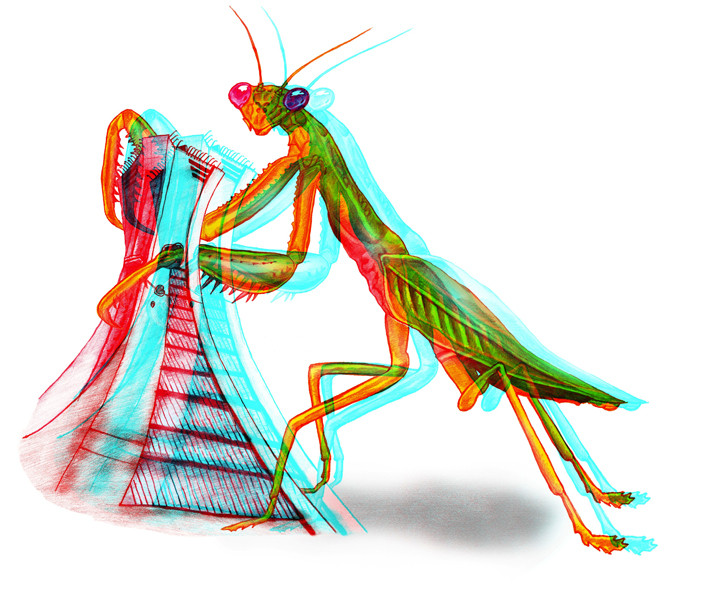The Third Dimension
Like some gothic horror story, 3D makes a bold return to prominence every few decades, feeding on theatre-goers’ dollars before entering a period of slumber, to return again and feed when the planets have properly aligned in their preordained cycles.
Or whenever Hollywood gets a burst of confidence as a result of new technological developments. You know, whichever comes first.
So it is with great skepticism that audiences assess the recent resurgence of stereoscopic 3D films, mostly spearheaded by blockbusters like 2009’s Avatar and especially by its writer and director, James Cameron.
“The debate isn’t whether 3D is here to stay,” says Munro Ferguson, an animation director who has produced 3D films for the National Film Board of Canada.
“There will always be 3D films,” continues Ferguson. “The question is whether 3D will completely overwhelm 2D the way colour films eventually overwhelmed black and white films.”
People forget, says Ferguson, that black and white films once dominated the cinema, and didn’t suffer a sudden death with the advent of colour film. Stereoscopic films represent a new cinematic language, says Ferguson, and both audiences and filmmakers are still learning how to use it.
“I think as audiences see more 3D films they’re […] starting to recognize the difference between good 3D and bad 3D and moving beyond the phase of looking at it as a gimmick and starting to expect more of it in terms of storytelling.”
Part of the reason 3D has failed to snowball in the past, says Alison Loader, a part-time faculty member of Concordia’s Mel Hoppenheim School of Cinema, is the relative quality of the stories it told.
“Because it’s so technically difficult to do, you need to attract a very large audience to pay for it, and so the films that have come out have never been particular good,” she says.
What you typically ended up getting in the 1950s and 80s, during 3D’s previous crop of major releases, were monster movies and lackluster franchise films like Jaws 3D.
“One of the things that people like to do when they go to the movies is to forget where they are, and it’s hard to forget where you are if you’ve got a stupid pair of glasses on and you’re getting a headache or if the story is so silly that it’s a distraction,” says Loader.
Scientifically, 3D vision occurs when the brain fuses the two different views from the left and right eye. While advances in stereoscopic technology have made inroads in reducing the visual anomalies that made earlier audiences queasy, no amount of money invested in equipping theaters with the latest technology will overcome audiences who bring their own anomalies into the theatre in the form of undiagnosed vision problems.
“In a sense [3D] becomes a very good clinical screener,” says Joceyln Faubert, director of the visual perception and psychophysics laboratory of the Université de Montréal, which uses stereoscopic technology to train athletes, among other things.
“Some people don’t know they have all of these little [visual anomalies],” he says, because they might have been considered too minor to send up any red flags. “And those people [become] uncomfortable because they’re straining to put two images together, and that’s something their brain doesn’t do well.”
Compounding the problem, says Faubert, is that cinematographers routinely stretch the limits of what the human eye can handle, like accommodating swift changes in depth of field, something the eye has no trouble perceiving in traditional cinema, which uses more subtler visual cues to suggest depth of field.
“But if people have difficulty adjusting to 3D now, just imagine how things were just 60 years ago,” says Loader.
Analogue equipment was more likely to produce misaligned left and right eye views, and small vibrations in the imagery led to eyestrain and headaches. Yet the challenges to 3D previous to digital production and projection were both technical and perceptual.
“If you were to show an audience from 1950 the kind of cutting you see in 2D films now, they would probably get upset and their eyes would hurt and it would annoy them,” she said. “It’s really hard to say it’s that [filmmakers] have to learn how to make 3D movies. Well, maybe we also have to learn how to watch them.”
But if the movie is any good, says Loader, people won’t notice the 3D.
“Hopefully the movie is so immersive that it stops mattering. They’ve gotten caught up in the story or the characters, so they’re not really thinking about it. That’s the other problem with 3D: if you watch it for too long, you stop thinking about it. You just sort of accept it as natural vision.”
Whatever challenges it continues to face, the medium is finally reaching critical mass, says Ferguson, with a large number of theatres already supporting the medium, and independent filmmakers like Wim Wenders and Werner Herzog exploring the artistic applications of the technology in documentary films.
“It’s conceivable that there will be a future time when people will look at 2D cinema the same way we look at black and white, as quaint and anachronistic,” he says.


_600_832_s.png)
